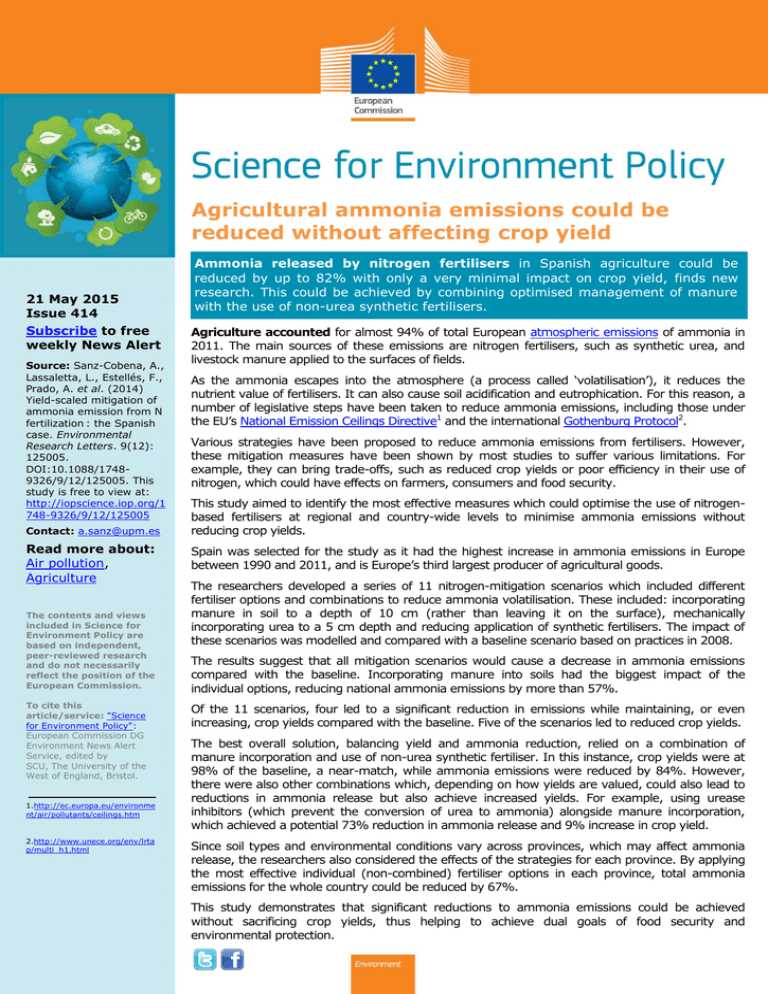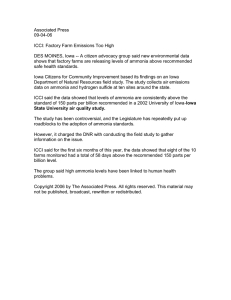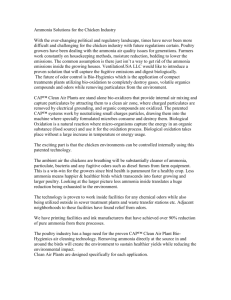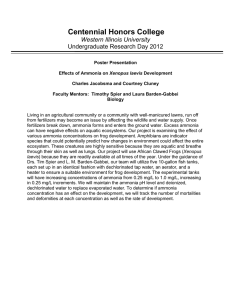Agricultural ammonia emissions could be reduced without affecting
advertisement

Agricultural ammonia emissions could be reduced without affecting crop yield 21 May 2015 Issue 414 Subscribe to free weekly News Alert Source: Sanz-Cobena, A., Lassaletta, L., Estellés, F., Prado, A. et al. (2014) Yield-scaled mitigation of ammonia emission from N fertilization : the Spanish case. Environmental Research Letters. 9(12): 125005. DOI:10.1088/17489326/9/12/125005. This study is free to view at: http://iopscience.iop.org/1 748-9326/9/12/125005 Contact: a.sanz@upm.es Read more about: Air pollution, Agriculture The contents and views included in Science for Environment Policy are based on independent, peer-reviewed research and do not necessarily reflect the position of the European Commission. To cite this article/service: "Science for Environment Policy": European Commission DG Environment News Alert Service, edited by SCU, The University of the West of England, Bristol. 1.http://ec.europa.eu/environme nt/air/pollutants/ceilings.htm 2.http://www.unece.org/env/lrta p/multi_h1.html Ammonia released by nitrogen fertilisers in Spanish agriculture could be reduced by up to 82% with only a very minimal impact on crop yield, finds new research. This could be achieved by combining optimised management of manure with the use of non-urea synthetic fertilisers. Agriculture accounted for almost 94% of total European atmospheric emissions of ammonia in 2011. The main sources of these emissions are nitrogen fertilisers, such as synthetic urea, and livestock manure applied to the surfaces of fields. As the ammonia escapes into the atmosphere (a process called ‘volatilisation’), it reduces the nutrient value of fertilisers. It can also cause soil acidification and eutrophication. For this reason, a number of legislative steps have been taken to reduce ammonia emissions, including those under the EU’s National Emission Ceilings Directive1 and the international Gothenburg Protocol2. Various strategies have been proposed to reduce ammonia emissions from fertilisers. However, these mitigation measures have been shown by most studies to suffer various limitations. For example, they can bring trade-offs, such as reduced crop yields or poor efficiency in their use of nitrogen, which could have effects on farmers, consumers and food security. This study aimed to identify the most effective measures which could optimise the use of nitrogenbased fertilisers at regional and country-wide levels to minimise ammonia emissions without reducing crop yields. Spain was selected for the study as it had the highest increase in ammonia emissions in Europe between 1990 and 2011, and is Europe’s third largest producer of agricultural goods. The researchers developed a series of 11 nitrogen-mitigation scenarios which included different fertiliser options and combinations to reduce ammonia volatilisation. These included: incorporating manure in soil to a depth of 10 cm (rather than leaving it on the surface), mechanically incorporating urea to a 5 cm depth and reducing application of synthetic fertilisers. The impact of these scenarios was modelled and compared with a baseline scenario based on practices in 2008. The results suggest that all mitigation scenarios would cause a decrease in ammonia emissions compared with the baseline. Incorporating manure into soils had the biggest impact of the individual options, reducing national ammonia emissions by more than 57%. Of the 11 scenarios, four led to a significant reduction in emissions while maintaining, or even increasing, crop yields compared with the baseline. Five of the scenarios led to reduced crop yields. The best overall solution, balancing yield and ammonia reduction, relied on a combination of manure incorporation and use of non-urea synthetic fertiliser. In this instance, crop yields were at 98% of the baseline, a near-match, while ammonia emissions were reduced by 84%. However, there were also other combinations which, depending on how yields are valued, could also lead to reductions in ammonia release but also achieve increased yields. For example, using urease inhibitors (which prevent the conversion of urea to ammonia) alongside manure incorporation, which achieved a potential 73% reduction in ammonia release and 9% increase in crop yield. Since soil types and environmental conditions vary across provinces, which may affect ammonia release, the researchers also considered the effects of the strategies for each province. By applying the most effective individual (non-combined) fertiliser options in each province, total ammonia emissions for the whole country could be reduced by 67%. This study demonstrates that significant reductions to ammonia emissions could be achieved without sacrificing crop yields, thus helping to achieve dual goals of food security and environmental protection.






